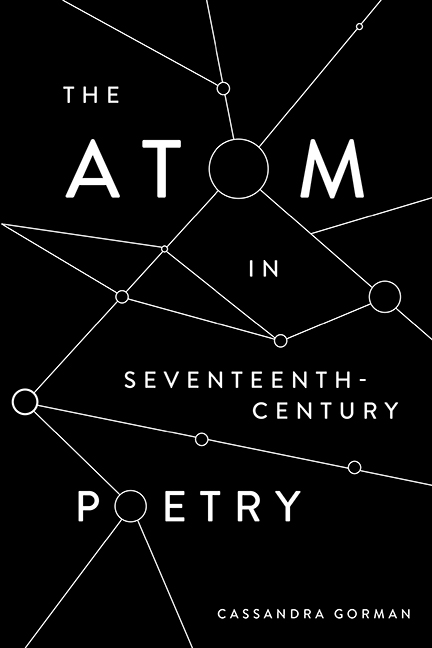Book contents
- Frontmatter
- Dedication
- Contents
- Acknowledgements
- Conventions and Abbreviations
- Introduction
- 1 Atomic Congruity: The Philosophical Poetry of Henry More
- 2 Thomas Traherne’s Atoms, Souls and Poems
- 3 World-Making and World-Breaking: The Atom Poems of Margaret Cavendish and Hester Pulter
- 4 The Atom in Genesis: Lucy Hutchinson’s Order and Disorder
- Afterword: A Poetics of the Atom
- Bibliography
- Index
- Studies in Renaissance Literature
- Frontmatter
- Dedication
- Contents
- Acknowledgements
- Conventions and Abbreviations
- Introduction
- 1 Atomic Congruity: The Philosophical Poetry of Henry More
- 2 Thomas Traherne’s Atoms, Souls and Poems
- 3 World-Making and World-Breaking: The Atom Poems of Margaret Cavendish and Hester Pulter
- 4 The Atom in Genesis: Lucy Hutchinson’s Order and Disorder
- Afterword: A Poetics of the Atom
- Bibliography
- Index
- Studies in Renaissance Literature
Summary
They say then that Love was the most ancient of all the gods; the most ancient therefore of all things whatever, except Chaos, which is said to have been coeval with him… And himself out of Chaos begot all things, the gods included. The attributes which are assigned to him are in number four: he is always an infant; he is blind; he is naked; he is an archer… The fable relates to the cradle and infancy of nature, and pierces deep. This Love I understand to be the appetite or instinct of primal matter; or to speak more plainly, the natural motion of the atom; which is indeed the original and unique force that constitutes and fashions all things out of matter. Now this is entirely without parent; that is, without cause… [T]he summary law of nature, that impulse of desire impressed by God upon the primary particles of matter which makes them come together, and which by repetition and multiplication produces all the variety of nature, is a thing which mortal thought may glance at, but can hardly take in.
(Francis Bacon, ‘Cupid, or the Atom’, De Sapientia Veterum)In his 1609 publication De Sapientia Veterum, Bacon sets out to discover the hidden, allegorical truths embedded in thirty-one figures from classical mythology. Though elsewhere he urges that ‘science must eliminate the fable and focus on facts’, his Preface to De Sapientia Veterum argues for the continued necessity of parables and similitudes to advance learning. These not only sweeten the pill when introducing new theories – allowing the philosopher to communicate without ‘offence or harshness’ – but also sustain communion with the divine in the pursuit of knowledge, evoking the very use of typological ‘veils and shadows’ that ‘religion delights in’. Allegories, even as they cloak and protect their hidden significance, allow the learner a glimpse of purer, more distant truths.
Memorably, Bacon includes amongst his mythologies the myth of Cupid, or ‘Love’, whom he equates with the ‘appetite or instinct of primal matter; or to speak more plainly, the natural motion of the atom’. In the section ‘Cupid, or the Atom’, Bacon traces the cryptic history of a complex figure who bears two forms from his classical origins. The newest and most recognisable of these is the cherubic infant, ‘youngest of all the gods, son of Venus’.
- Type
- Chapter
- Information
- The Atom in Seventeenth-Century Literature , pp. 1 - 36Publisher: Boydell & BrewerPrint publication year: 2021



